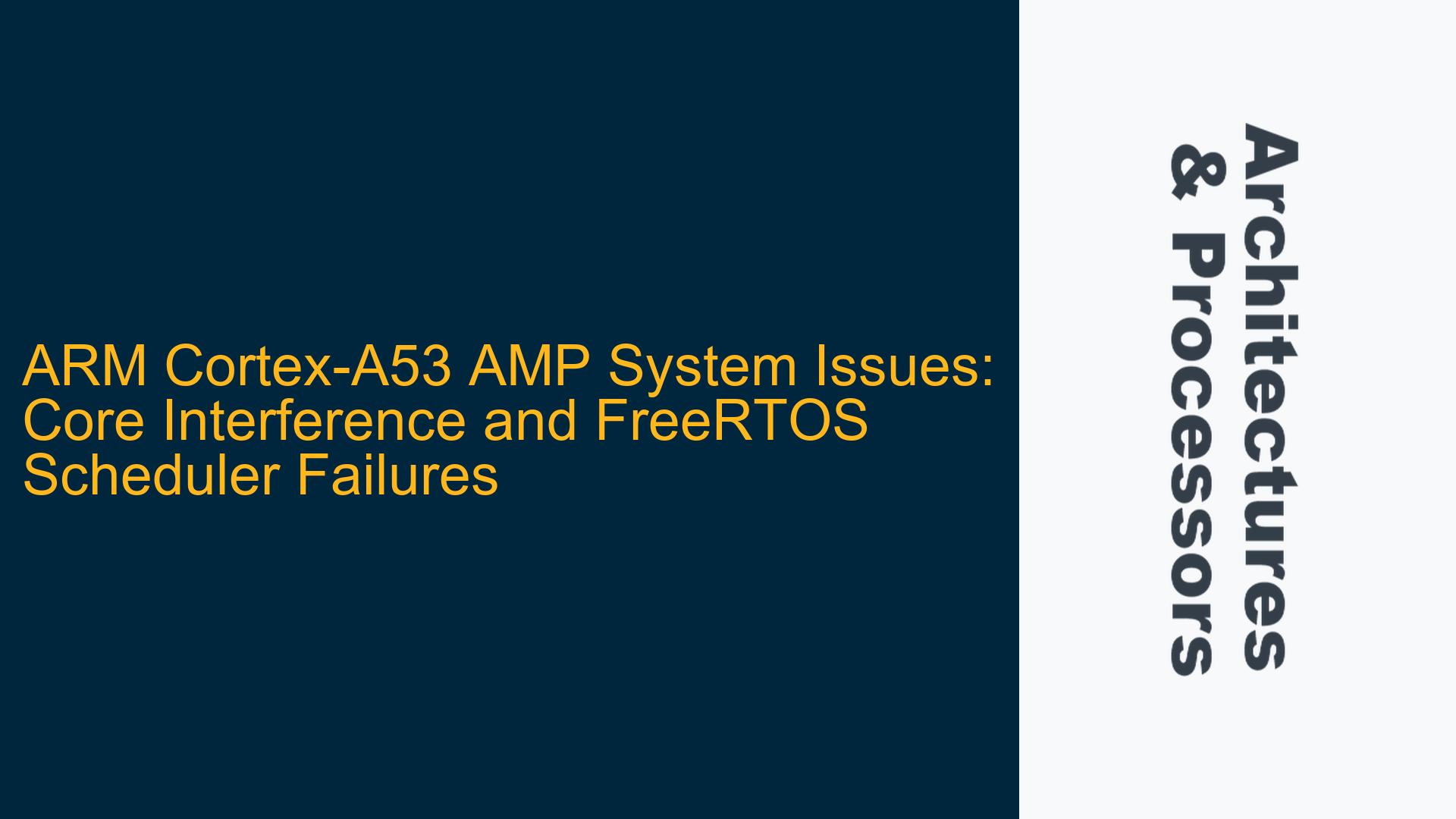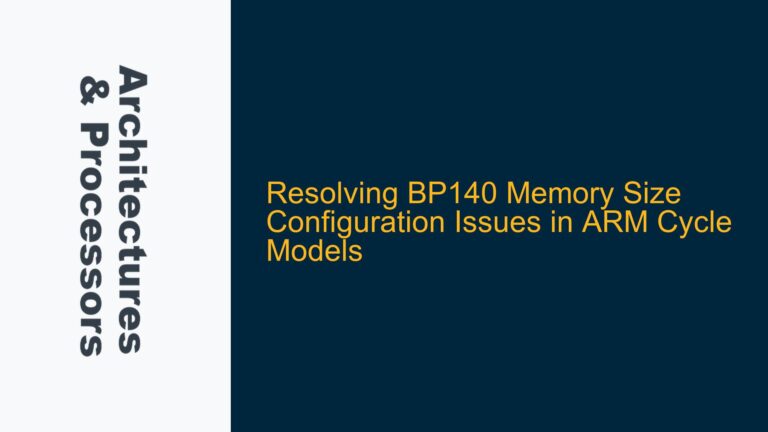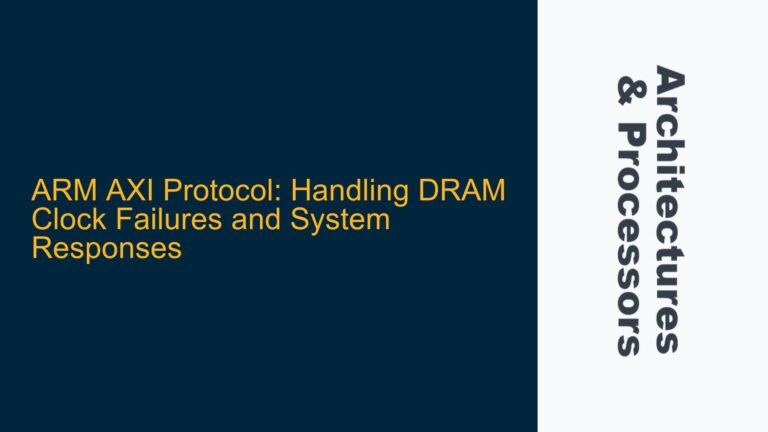Cortex-A53 Core Interference During High-Bandwidth Network Transfers
The core issue revolves around an Asynchronous Multi-Processing (AMP) system implementation on an ARM Cortex-A53 processor, where multiple cores are tasked with running bare-metal and FreeRTOS-based applications concurrently. The system exhibits instability when FreeRTOS is introduced on Core 3 and Core 4, particularly during high-bandwidth network transfers between Core 0 and Core 3. The FreeRTOS scheduler fails to operate correctly on Core 3 and Core 4, with no task switching occurring despite proper interrupt routing. Additionally, Core 0 experiences real-time performance degradation over time, leading to network transfer failures and DMA synchronization loss with programmable logic (PL). These issues suggest underlying hardware-software interaction problems, potentially related to shared resources, cache coherency, or interrupt handling inconsistencies across the cores.
The problem is exacerbated when Core 3 is introduced into the system, indicating that Core 2 and Core 3 may have architectural differences or shared resources that are not immediately apparent. The block diagram referenced in the discussion shows Core 3 and Core 4 with dashed lines, hinting at potential differences in their implementation or connectivity compared to Core 0 and Core 1. This observation aligns with the symptoms described, where Core 2 and Core 3 exhibit inconsistent behavior when running FreeRTOS or handling network traffic.
Shared Resource Contention and Cache Coherency Issues
The root cause of the instability in the AMP system likely stems from shared resource contention and cache coherency issues. The Cortex-A53 processor features a shared L2 cache and other system-level resources, such as the Generic Interrupt Controller (GIC), which may not be properly managed in the current implementation. When Core 0 and Core 3 engage in high-bandwidth network transfers, the shared L2 cache can become a bottleneck, leading to performance degradation and eventual system failure. The FreeRTOS scheduler’s inability to function on Core 3 and Core 4 further suggests that interrupt handling or tick generation may be affected by resource contention or improper cache management.
Another potential cause is the lack of proper memory barriers or cache invalidation routines in the bare-metal and FreeRTOS code. Without these synchronization mechanisms, cores may operate on stale or inconsistent data, leading to unpredictable behavior. The issue is particularly pronounced in AMP systems, where cores operate independently but share common resources. The absence of a hypervisor or OpenAMP framework exacerbates the problem, as there is no centralized mechanism to manage resource allocation and synchronization between cores.
The dashed lines in the block diagram for Core 3 and Core 4 may indicate that these cores have limited access to certain system resources or are connected differently within the processor’s interconnect fabric. This architectural nuance could explain why Core 3 and Core 4 exhibit different behavior compared to Core 0 and Core 1. For example, Core 3 and Core 4 might have reduced bandwidth to the shared L2 cache or limited access to the GIC, leading to interrupt handling delays or missed ticks in the FreeRTOS scheduler.
Implementing Cache Management and Interrupt Isolation
To address the issues in the AMP system, a comprehensive approach involving cache management, interrupt isolation, and resource allocation is required. The first step is to ensure proper cache coherency by implementing data synchronization barriers and cache invalidation routines in both the bare-metal and FreeRTOS code. This will prevent cores from operating on stale data and ensure consistent memory access across the system. For example, the DSB (Data Synchronization Barrier) and ISB (Instruction Synchronization Barrier) instructions should be used to enforce memory ordering and synchronization between cores.
Next, interrupt handling must be optimized to ensure that each core receives its designated interrupts without interference. The GIC should be configured to route interrupts exclusively to the intended cores, and interrupt priorities should be carefully managed to prevent starvation or delays. For FreeRTOS, the tick interrupt must be correctly routed and handled to ensure proper scheduler operation. This may involve modifying the FreeRTOS port layer to account for the specific interrupt routing and timing requirements of the Cortex-A53 processor.
Resource allocation should also be reviewed to minimize contention between cores. The shared L2 cache can be partitioned or managed using cache locking mechanisms to ensure that high-bandwidth operations on Core 0 and Core 3 do not degrade performance on other cores. Additionally, the system interconnect fabric should be analyzed to identify potential bottlenecks or asymmetries in resource access for Core 3 and Core 4. If these cores have limited access to certain resources, their workloads may need to be adjusted to compensate for these limitations.
Finally, the use of a hypervisor or OpenAMP framework should be considered to provide centralized management of resource allocation and synchronization between cores. While this approach may require significant rework of the existing system, it offers a more robust and scalable solution for AMP systems with complex workloads. The hypervisor can manage interrupt routing, cache coherency, and resource allocation, reducing the burden on individual cores and ensuring consistent performance across the system.
By addressing these issues through careful cache management, interrupt isolation, and resource allocation, the AMP system can achieve stable and reliable operation across all cores. The following table summarizes the key steps and their impact on system performance:
| Step | Description | Impact on System Performance |
|---|---|---|
| Cache Management | Implement data synchronization barriers and cache invalidation routines | Ensures consistent memory access and prevents cores from operating on stale data |
| Interrupt Isolation | Configure GIC to route interrupts exclusively to intended cores | Prevents interrupt interference and ensures proper tick generation for FreeRTOS |
| Resource Allocation | Partition shared L2 cache and analyze system interconnect fabric | Reduces contention and ensures fair access to shared resources |
| Hypervisor/OpenAMP Framework | Implement centralized management of resource allocation and synchronization | Provides scalable and robust solution for AMP systems with complex workloads |
In conclusion, the instability in the Cortex-A53 AMP system is likely caused by shared resource contention, cache coherency issues, and improper interrupt handling. By implementing cache management routines, optimizing interrupt isolation, and reviewing resource allocation, the system can achieve stable and reliable operation across all cores. The use of a hypervisor or OpenAMP framework offers a long-term solution for managing complex AMP workloads and ensuring consistent performance.






